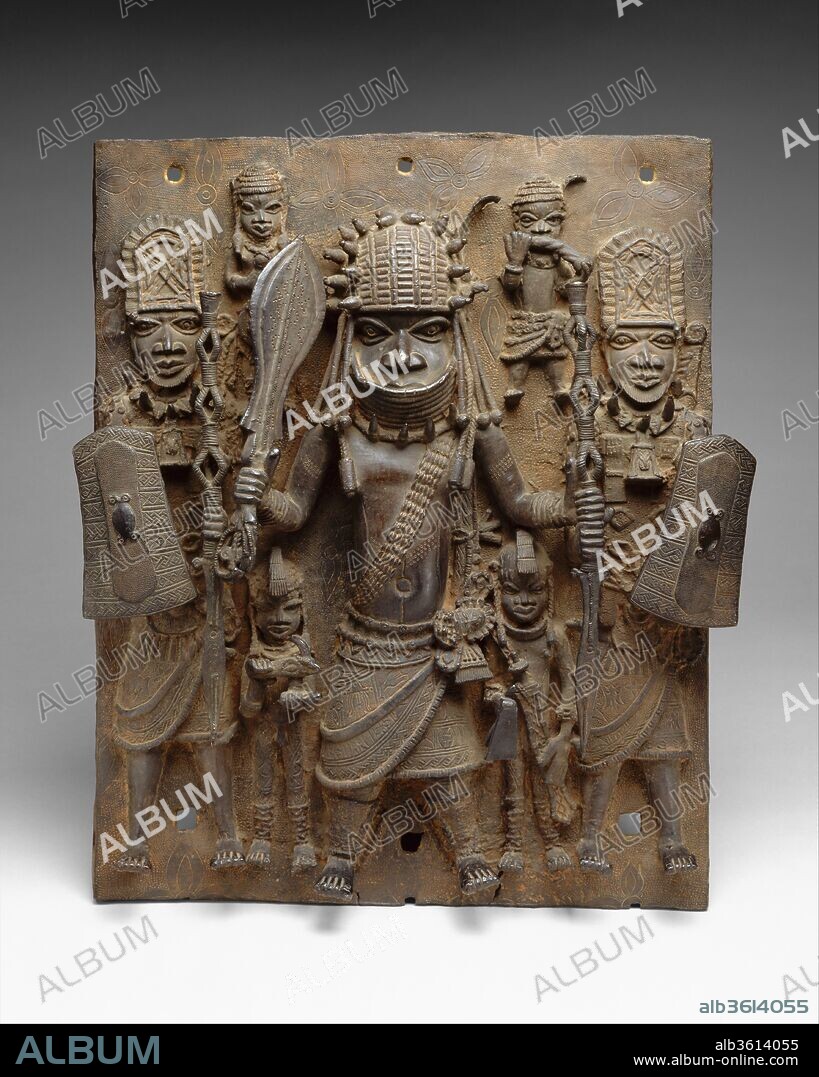alb3614055
Plaque: Warrior and Attendants

|
Zu einem anderen Lightbox hinzufügen |
|
Zu einem anderen Lightbox hinzufügen |



Haben Sie bereits ein Konto? Anmelden
Sie haben kein Konto? Registrieren
Dieses Bild kaufen

Titel:
Plaque: Warrior and Attendants
Untertitel:
Automatische Übersetzung: Plakette: Krieger und Diener. Kultur: Edo-Völker. Maße: H. 18 3/4 Zoll (47,6 cm). Datum: 16.-17. Jahrhundert. Im 16. und 17. Jahrhundert wurde eine bemerkenswerte Reihe von Werken geschaffen, um die Außenseite des königlichen Palastes in Benin City zu schmücken. Olfert Dapper, ein niederländischer Besucher des Hofes von Benin im 17. Jahrhundert, beschrieb den weitläufigen Palastkomplex ? mit seinen vielen großen Höfen und Galerien ? als einen Komplex aus Holzsäulen, die von oben bis unten mit rechteckigen Plaketten aus Messingguss bedeckt waren. Diese Plaketten haben eine eigenständige Bedeutung und erzählen in ihrer Beziehung zueinander komplexe Geschichten. Irgendwann wurden die Plaketten von der Palastfassade entfernt, da sie nicht mehr da waren, als die Briten in der Region ankamen. Ein Gelehrter hat vermutet, dass sie ?wie eine Karteikarte bis zur Zeit der Strafexpedition aufbewahrt und herangezogen wurden, wenn es einen Streit über die höfische Etikette gab.? Den Autoren solcher Werke ging es viel mehr um die Vermittlung von Hierarchien und Status als um die Erfassung individueller körperlicher Merkmale. Diese Plaketten entsprechen einer Konvention ?hierarchischer Proportionen?, wobei die größte Figur diejenige mit der größten Autorität und dem größten Rang ist. In diesem Beispiel handelt es sich um einen Kriegerhäuptling. Er befindet sich in der Mitte, flankiert auf beiden Seiten von Soldaten niedrigeren Ranges. Insignien und Statussymbole werden gegenüber allen anderen Aspekten des dargestellten Subjekts hervorgehoben. So wird der Krieger beispielsweise mit Skarifikationen in Leopardenfleckenform und einer Halskette aus Leopardenzähnen gezeigt, die ihn mit der Heimlichkeit, Geschwindigkeit und Wildheit des Leoparden in Verbindung bringen. Als ?König des Busches? ist der Leopard eines der Hauptsymbole des Benin-Königtums. Darüber hinaus trägt der Kriegerhäuptling einen mit Korallen besetzten Helm und Kragen, einen üppigen Umhang und ein Messingornament an seiner Hüfte. In seiner linken Hand trägt er ein zeremonielles Schwert, eine Geste der Ehre und Treue, und hält in seiner anderen Hand einen Speer. Der unterwürfige Status der Figuren, die den Kriegerhäuptling flankieren, wird durch die Gegenstände angezeigt, die sie tragen. Ein Diener hat einen Ventilator, der den Kriegerhäuptling kühlt, der andere eine Trompete, um seine Anwesenheit anzukündigen. Ein dritter Diener bringt eine Kiste mit einem Opfer aus Kolanüssen für den Oba (König).
Plaque: Warrior and Attendants. Culture: Edo peoples. Dimensions: H. 18 3/4 in. (47.6 cm). Date: 16th-17th century.
During the sixteenth and seventeenth centuries, a remarkable series of works were created to adorn the exterior of the royal palace in Benin City. A seventeenth-century Dutch visitor to the court of Benin, Olfert Dapper, described the sprawling palace complex--with its many large courtyards and galleries--as containing wooden pillars covered from top to bottom with rectangular cast brass plaques. These plaques are understood to have autonomous meaning and to tell complex narratives in relationship to one another. At some point the plaques were removed from the palace facade, as they were no longer there when the British arrived in the region. One scholar has surmised that they "were kept like a card index up to the time of the Punitive Expedition, and referred to when there was a dispute about courtly etiquette."
The authors of such works were far more concerned with the communication of hierarchies and status than in capturing individual physical features. These plaques conform to a convention of "hierarchical proportions" wherein the largest figure is the one with the greatest authority and rank. In this example, it is a warrior chief. He is in the center, flanked on either side by soldiers of lesser rank. Regalia and symbols of status are emphasized above all other aspects of the subject depicted. For example, the warrior is shown with leopard-spot scarification marks and a leopard-tooth necklace, which associate him with the stealth, speed, and ferocity of the leopard. As "king of the bush," the leopard is one of the principle symbols of Benin kingship. Additionally, the warrior chief wears a coral-studded helmet and collar, a lavish wrap, and a brass ornament on his hip. In his left hand he carries a ceremonial sword, a gesture of honor and loyalty, and holds a spear in his other hand.
The servile status of the figures flanking the warrior chief is indicated by the objects they carry. One attendant has a fan used to cool the warrior chief, the other a trumpet to announce his presence. A third attendant brings a box containing an offering of kola nuts for the oba (king).
Technik/Material:
Latón
Museum:
Metropolitan Museum of Art, New York, USA
Bildnachweis:
Album / Metropolitan Museum of Art, NY
Freigaben (Releases):
Model: Nein - Eigentum: Nein
Rechtefragen?
Rechtefragen?
Bildgröße:
3276 x 4094 px | 38.4 MB
Druckgröße:
27.7 x 34.7 cm | 10.9 x 13.6 in (300 dpi)
Schlüsselwörter:
 Pinterest
Pinterest Twitter
Twitter Facebook
Facebook Link kopieren
Link kopieren Email
Email
